Milkyway Over Mangroves
As I sat watching one arm of our galaxy traverse across the sky, I mulled the dichotomy of the Sundarbans and its place in our Universe. This was a land both life-giving and life-taking.

View print sizes for Milkyway Over Mangroves by Arati Kumar-Rao:
Story Behind the Photograph: Milkyway Over Mangroves
Night falls like a black hood over the largest mangrove forest in the world, the Sundarbans. Straddling the border between Bangladesh and India, this beautiful forest (which is likely where it gets its name from — Sundar, meaning beautiful, ban, meaning forest) is home to the Royal Bengal Tiger, saltwater crocodiles, all manner of snakes, crustaceans, river sharks, and a few million crab-catchers, fishers, and honey hunters.
I’d travelled 2000 kilometers (1250 miles) to reach the edge of the Sundarbans and then taken two ferries and three flatbed tuk-tuks to reach the last embankment on the edge of the forest. It was dark by the time I lugged my drone and bags into the little room I’d taken by the river. Climbing up on to the embankment an hour later, I saw the forest lying dark across the river. The milkyway dissolved into view. Lightning lit up the clouds on the far side of the forest. Occasionally a night fisherman would put-put across my field of view. An incessant chizzzzzz of crickets filled the monsoon air. I set up my camera and prepared to sit through the long exposures on the steps leading up to a small jetty.
As I sat watching one arm of our galaxy traverse across the sky, I mulled the dichotomy of the Sundarbans and its place in our Universe. This was a land both life-giving and life-taking. Tigers killed more humans here than in any other place in the world. The big cat was known to swim across rivers and onto land and into villages to hunt. Yet, this estuary was one of the richest fishing of grounds and is the first line of defense against storm surges, rising sea levels, and cyclones.
About Untamed Photographer
Untamed Photographer is an online art gallery that brings together wildlife photography and stories from a range of international environmental artists, both emerging and established.
Structured as an online marketplace, Untamed Photographer offers a selection of handpicked, limited-edition works of art, alongside the photographers’ compelling stories of what occurred in the wild to get the shot. The exclusive limited-edition pieces are printed in Miami and come with an artist-signed certificate of authenticity from their respective worldwide locations.
The Nature Trust of the Americas (NTOTA) was founded with the mission to give back. While building awareness for NTOTA’s causes, the founders met talented nature photographers who are passionate not only about photography, but also about saving the planet. Their life’s work and stories are inspiring, and their art, passion and stories deserve to be shared on a platform that benefits the environmental causes they are dedicated to.
Just as the photographers preserve the beauty of the planet in their art, Untamed Photographer is dedicated to preserving the planet for the future. All profits from photographs go to Untamed Photographer's two pillars: the artists and causes that protect the environment, ecosystems, and wildlife.
About the Photographer: Arati Kumar-Rao
Arati Kumar-Rao is a National Geographic Explorer, an independent environmental photographer, writer, and artist documenting the slow violence of ecological degradation. She communicates through photos, long-form narratives, and art.
Arati crisscrosses the South Asian subcontinent following a single story, across seasons, sometimes over years, in order to chronicle South Asia’s changing landscapes and climate, and its effect on livelihoods and biodiversity.
Arati is currently on a National Geographic Explorer grant to document forced human migration and is working on her first book.
Arati’s work has appeared in The National Geographic Magazine, The Hindu, #Dysturb, The Guardian, BBC Outside Source, Hindustan Times, Mint, and other outlets. She contributes to @EverydayClimateChange and @EverydayExtinction on Instagram and has been exhibited in India and internationally.
When not in the field, she calls Bangalore home where she raises three rescued cats.
About the Creator
Arati Kumar-Rao
Arati Kumar-Rao is a National Geographic Explorer and an independent photographer, writer, and artist who chronicles the effect of South Asia’s changing landscapes on livelihoods and biodiversity. She is based in Bangalore, India.








Comments
There are no comments for this story
Be the first to respond and start the conversation.